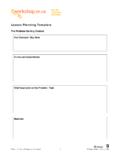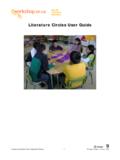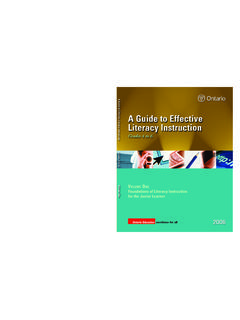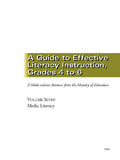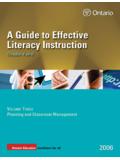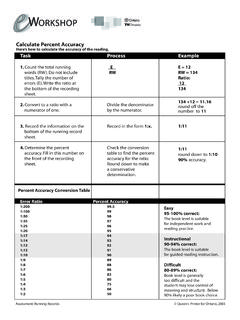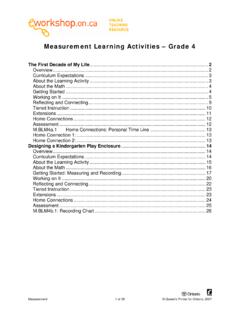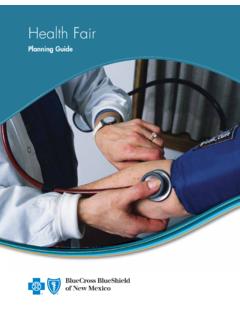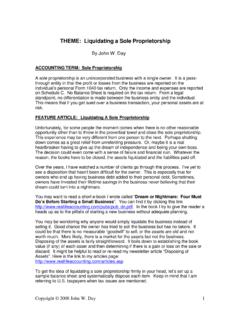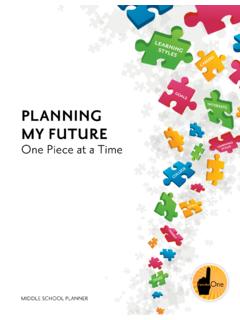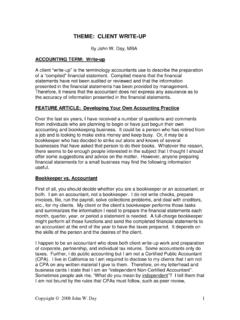Transcription of Intent Form Lesson Plan for Media Literacy
1 Media Literacy 1 Queen's Printer for Ontario, 2006 Constructions Beliefs & Values Audience Intent form Lesson Focus: What is the focus of the Lesson ? How will I teach it? The Lesson will focus on how to use the Guiding Questions from the TEXT side of the Media Triangle to deconstruct a poster. The Lesson begins with a whole-class modelled Lesson . Then the students analyse other posters in small groups and come back to the whole group to share their findings. Another poster will be used during a guided Lesson with students who are still experiencing difficulty with the Guiding Questions.
2 As students begin to work on their own posters, student-teacher conferencing will take place. Rationale: Why am I teaching this Lesson ? The students will be creating posters to communicate an active living message. An understanding of the decisions that are made when creating posters will strengthen the students understanding of the importance of these text decisions when they create their own posters. Assessment: How will I know when my students are successful? Information regarding the students degree of success will be provided by observing them and recording the assessment data using the following tools: Anecdotal Record Sheet Poster Elements Checklist Poster Creation Rubric Prior Knowledge: What prior knowledge do my students need in order to be successful with the focus of this Lesson ?
3 Prior to this Lesson , students will need to: view some examples of posters; understand the characteristics of effective posters; understand the Media Triangle; have experience using visual arts tools and be able to work cooperatively in groups. Lesson plan for Media Literacy Audience Production Text Media Literacy 2 Queen's Printer for Ontario, 2006 Curriculum Expectations: What expectations will I address? Language: Media Literacy : Grade 4 Analysing: identify the purpose and audience for a variety of Media texts; use overt and implied messages to draw inferences and construct meaning in Media texts; express opinions about ideas, issues, and/or experiences presented in Media texts, and give evidence from the texts to support their opinions.
4 Identify whose point of view is presented or reflected in a Media text, citing supporting evidence from the text, and suggest how the text might change if a different point of view were used; identify the conventions and techniques used in some familiar Media forms and explain how they help convey meaning; Creating: describe in detail the topic, purpose, and audience for Media texts they plan to create; identify conventions and techniques appropriate to the form chosen for a Media text they plan to create; produce Media texts for specific purposes and audiences, using a few simple Media forms and appropriate conventions and techniques; The Arts: Visual Arts: Grade 4 produce two- and three-dimensional works of art that communicate thoughts, feelings, and ideas for specific purposes and to specific audiences.
5 Healthy Living: Grade 4 identify the physical, interpersonal, and emotional aspects of healthy human beings; identify the factors that motivate participation in daily physical activity. Materials/Preparation for Teaching: What do I need to know, have, and be able to do before I can begin the Lesson ? Pause to PLAY poster from ( , hockey or volleyball for guided Lesson ) Media Triangle TEXT Guiding Questions (class anchor chart) Media Triangle TEXT Guiding Questions (graphic organizer) Variety of printed material Anecdotal Record Sheet Poster Elements Checklist Poster Creation Rubric Media Literacy 3 Queen's Printer for Ontario, 2006 Differentiated Instruction: How can I ensure that I am meeting the needs of all my students?
6 Ask students to bring in posters. Using student materials will heighten the interest of reluctant learners. Obtain posters in the native language of any English Language Learners (ELL) and use these posters during a guided Lesson with these students. Ensure that any ELL and/or IEP students are paired up with high-ability students when working in smaller groups, forming heterogeneous groupings. A possible extension: Ask students to align the Guiding Questions for TEXT with the Core Concepts, and to explain their thinking.
7 Modelled/Shared Lesson : Before: Engage students in the Lesson by posing a challenge masking (the slogan) part of a PSA poster and asking students to predict what the hidden part says. During: Deconstruct a fitness poster (hockey) using Media Triangle TEXT Guiding Questions. Use a think-aloud strategy to model the first question What is it? , explaining why the poster is a PSA. Continue to use a think-aloud strategy with each of the other Guiding Questions, eliciting more and more answers from the class.
8 After: Have students practise deconstructing various print materials at their tables and record their findings on their graphic organizer. Have the whole class share their deconstructions of the various print materials using a large-scale graphic organizer. Independent Whole Group: Have students work on their active living promotional posters. Circulate and observe students using the Poster Elements Checklist. Guided Small Group: Work with students (no more than 6 at a time) who are experiencing difficulty with the Guiding Questions.
9 Deconstruct another poster ( , Pause to PLAY: Volleyball ) using the Media Conferencing Small Group: Conference with 2 students regarding the rough drafts of their posters. Referring to the Poster Elements Checklist, record individual student progress on the Anecdotal Record Media Literacy 4 Queen's Printer for Ontario, 2006 Record findings on the Anecdotal Record Sheet. Triangle TEXT Guiding Questions graphic organizer. Sheet. Discuss next steps with these students, constantly referring to the Poster Creation Rubric.
10 Sharing/Reflection: Were my students successful? Did my instructional decisions meet the needs of all students? What worked well? What will I do differently in the future? What are my next steps? This section would be completed after the Lesson . Media Literacy 5 Queen's Printer for Ontario, 2006 Media Literacy 6 Queen's Printer for Ontario, 2006 Media Literacy 7 Queen's Printer for Ontario, 2006 Media Triangle TEXT Guiding Questions Text Title: _____ What is it?
